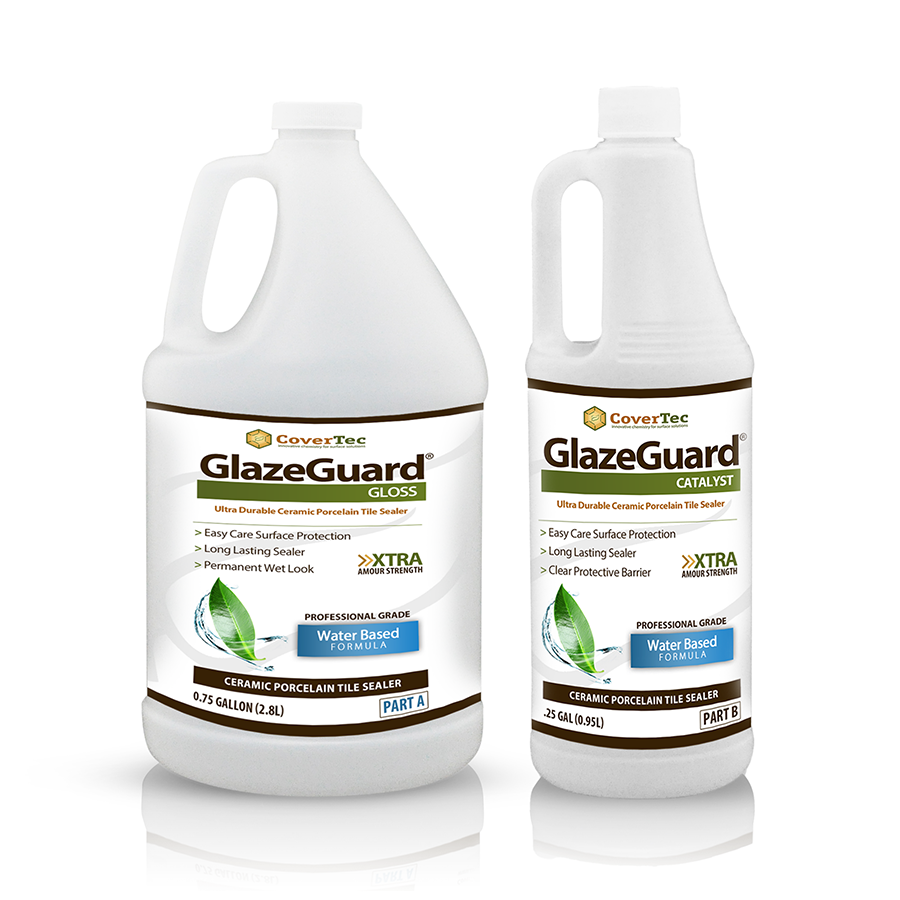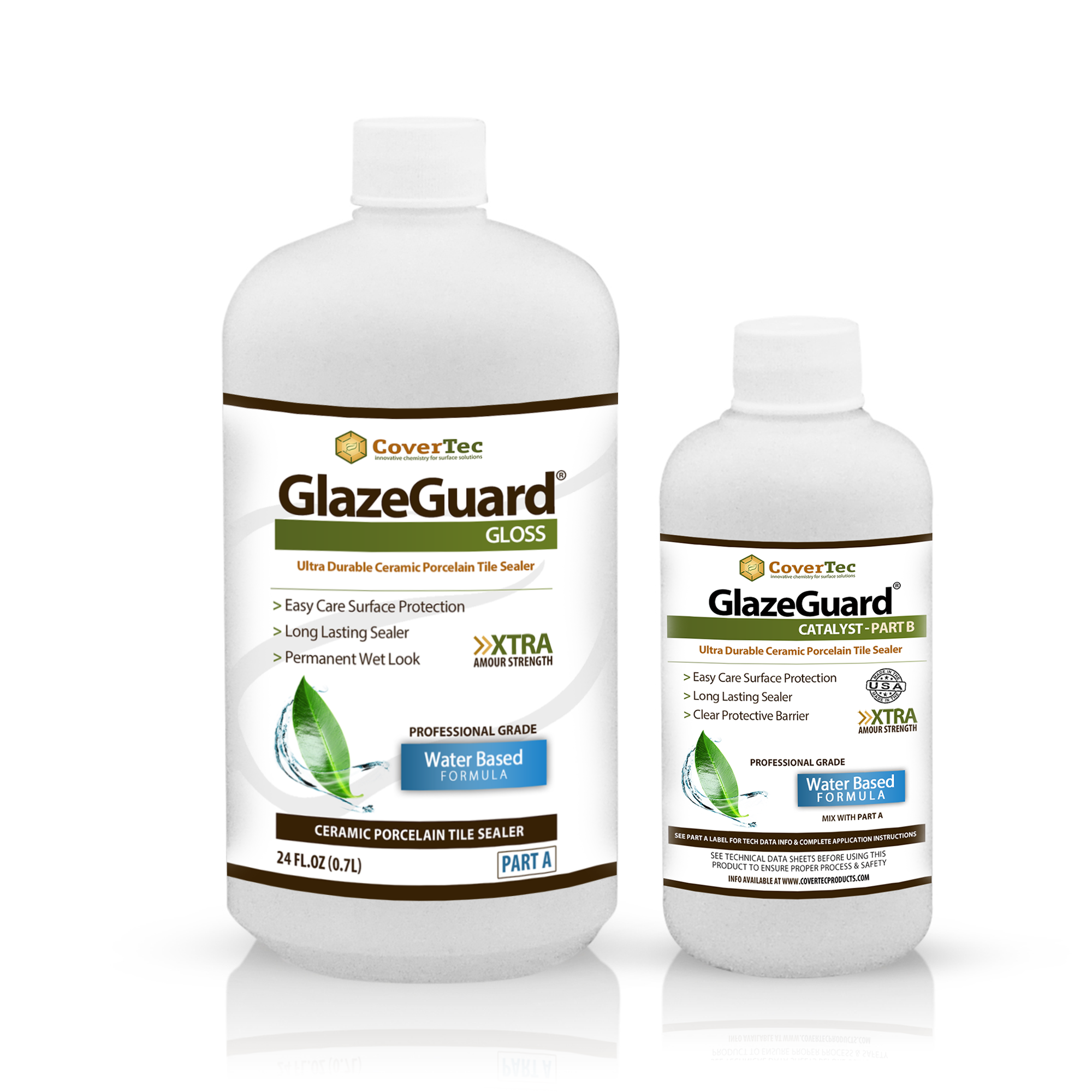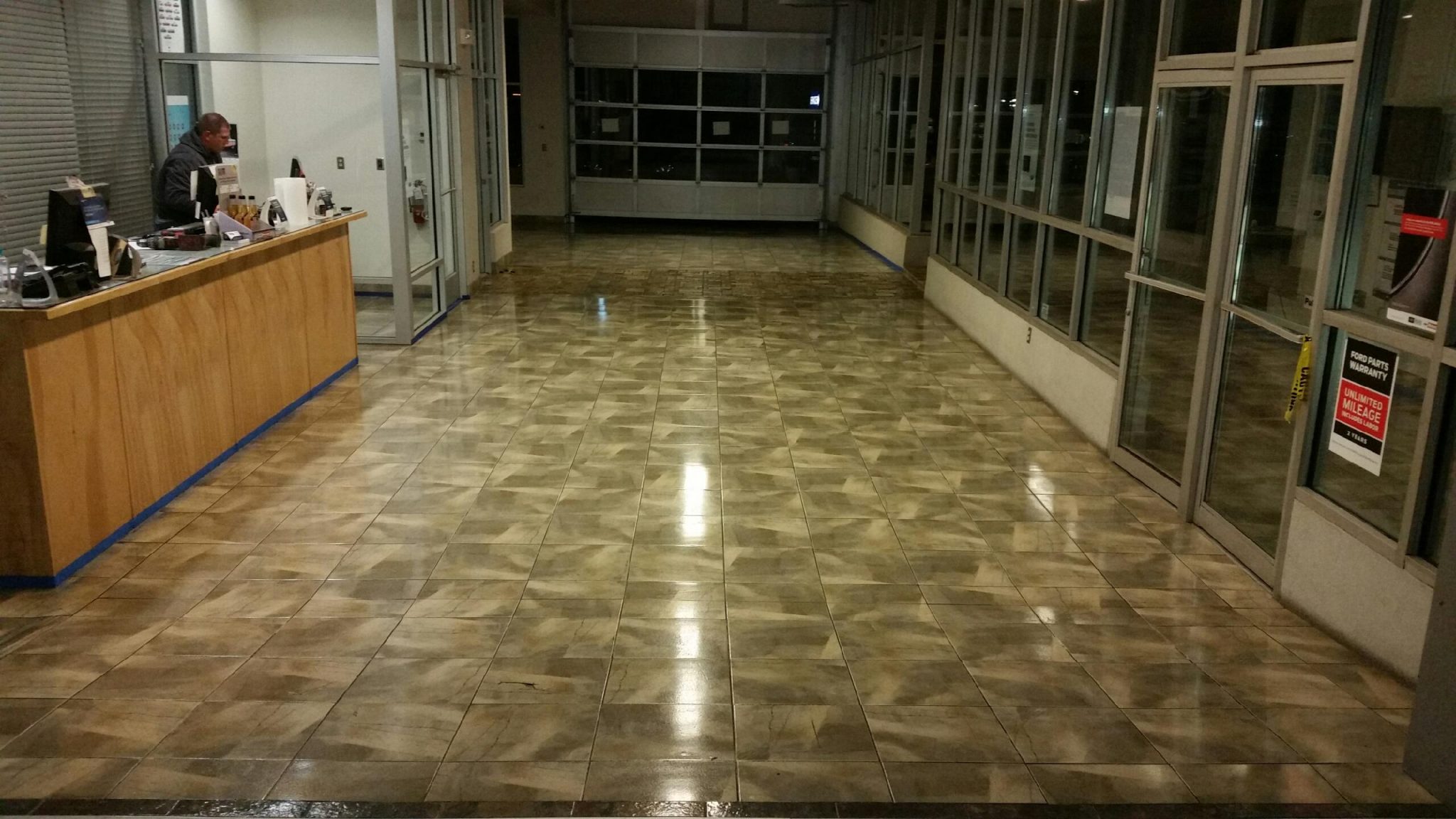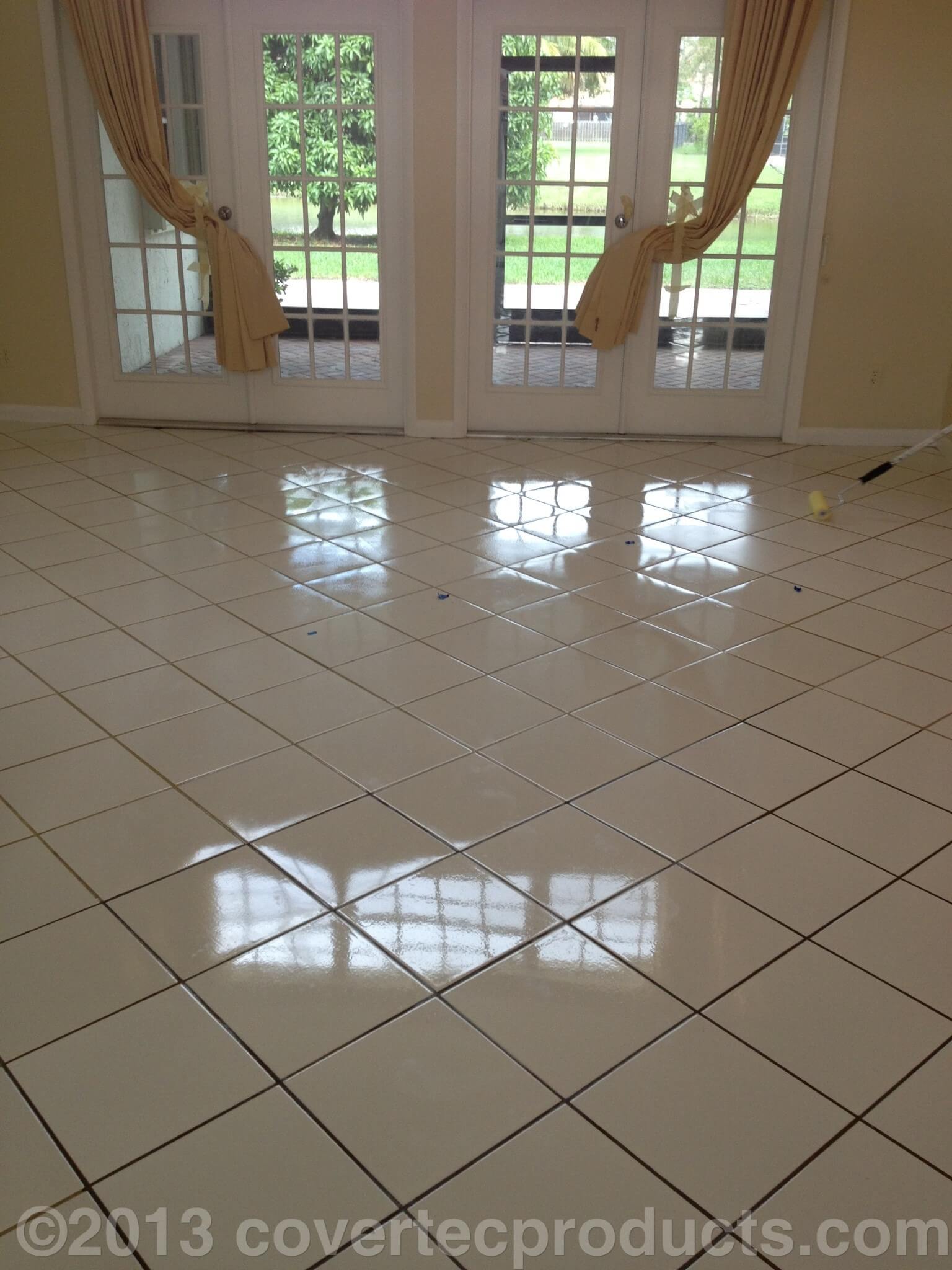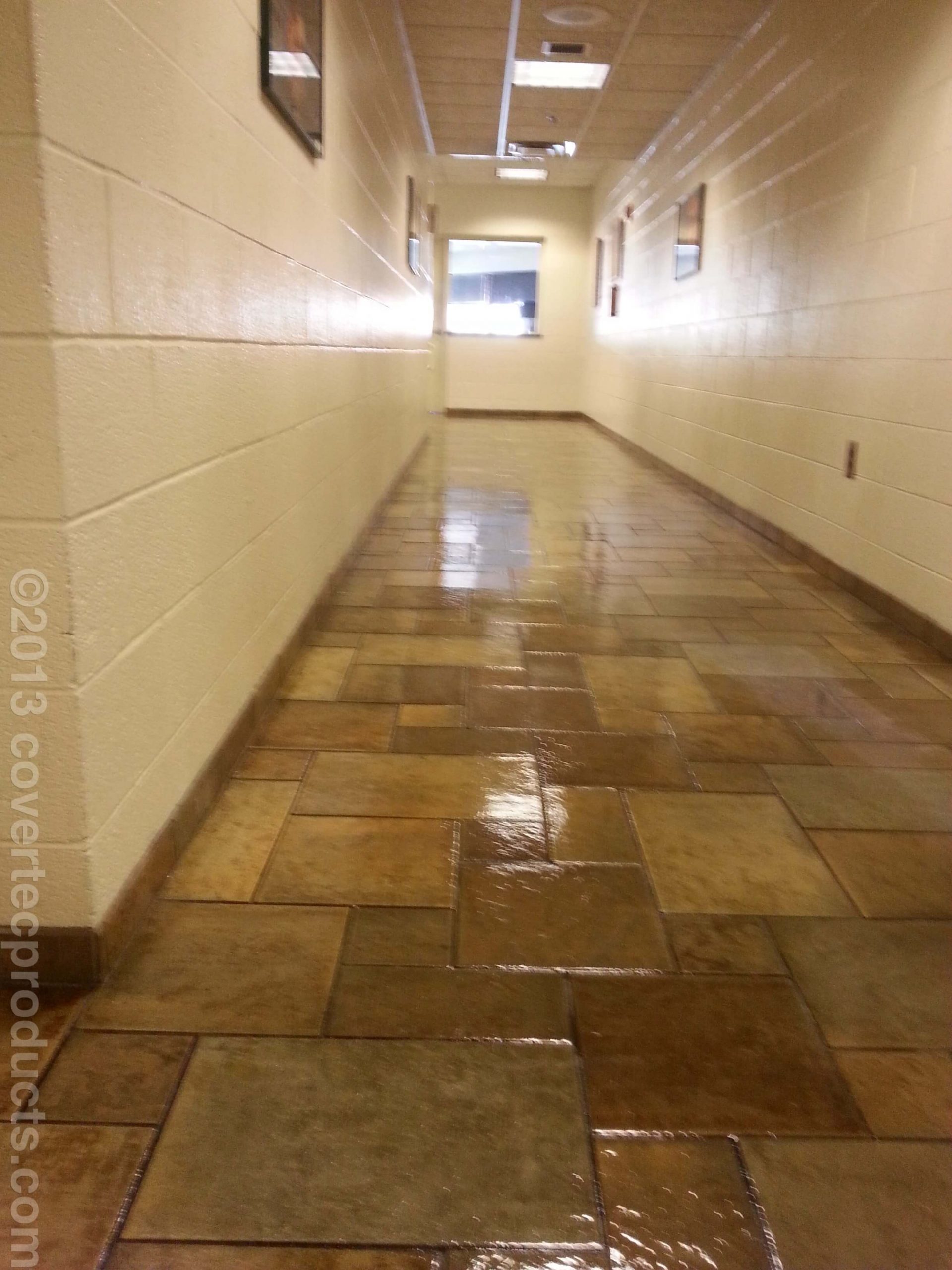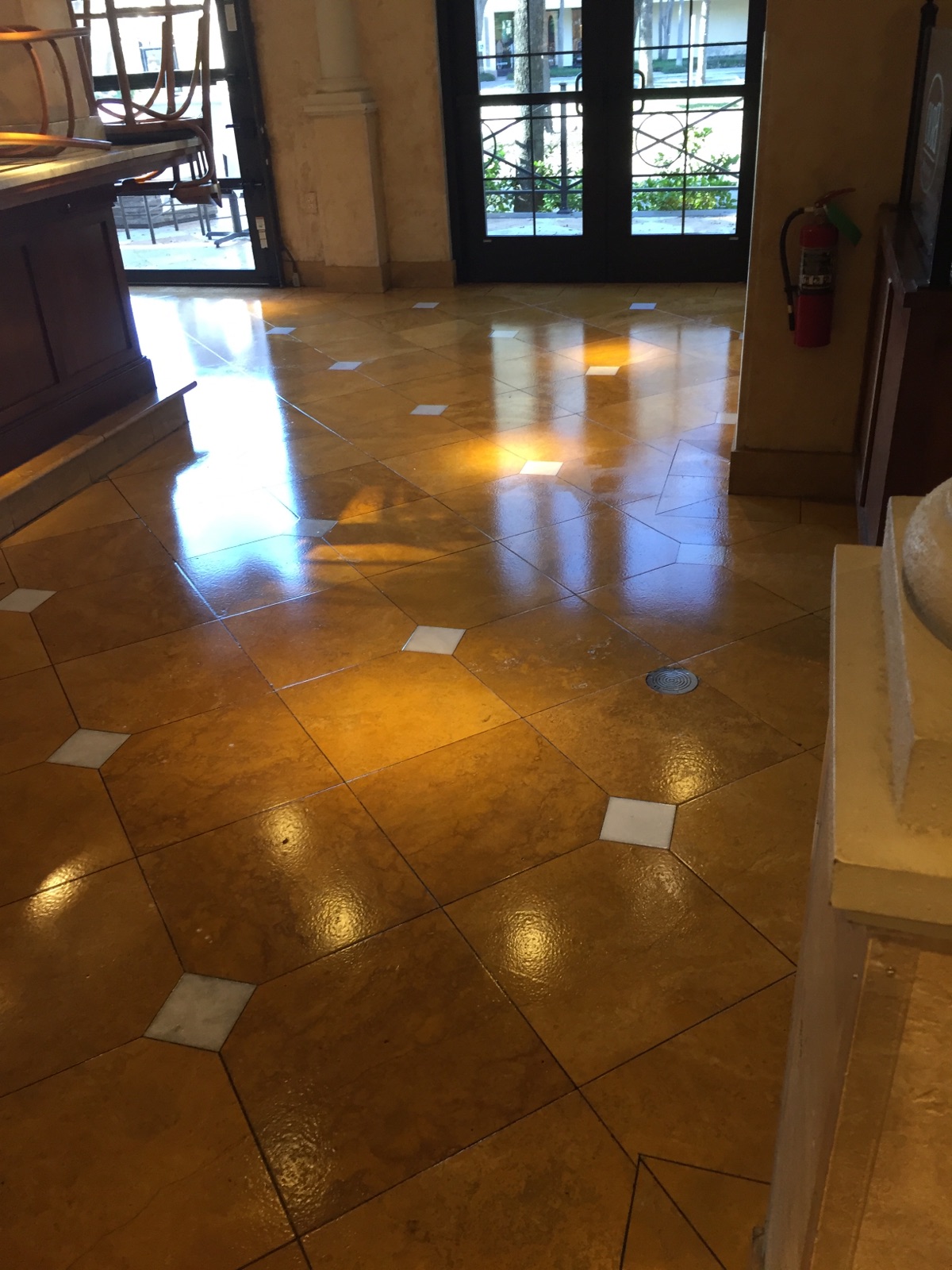GlazeGuard Ceramic & Porcelain Tile Sealer – High Gloss, Wet Look Finish
$14.00 – $638.30
FREE Shipping on all orders above $20 in the continental US
Frequently Bought Together
GlazeGuard® High Gloss Sealer For Porcelain, Stone And Ceramic Tiles
Ultra Durable Clear Sealer for Ceramic, Porcelain and Stone Tile
GlazeGuard Gloss Product Video
GlazeGuard Gloss Unboxing Video
How to Apply GlazeGuard®
How to Repair Scratches on GlazeGuard®
What Is GlazeGuard® High Gloss Sealer For Porcelain, Stone And Ceramic Tiles?
If you use a product for sealing ceramic or porcelain tile that’s not designed specifically for that surface, the problem is that it’s going to lift and peel.
Standard surface sealers need to absorb into the surface. Ceramic and porcelain are so dense that you won’t get that result.
You need something that’s got some adhesion promotion that will allow you to bond to the surface. Similarly, if you use penetrating or impregnating sealers, they need to soak into the surface. You can’t achieve that with a dense ceramic or porcelain tile. So it will not change the sheen, and it will also wear off very quickly.
Now if you use something like the GlazeGuard® Gloss, this is designed specifically to bond to that surface. It will provide a nice film across the tile and the grout. and a high sheen, wet look that will last for many years.
Why Is GlazeGuard® Gloss Better Than Other Sealer Products?
Our GlazeGuard® Gloss porcelain and ceramic tile sealer is a two-part polyurethane sealer designed specifically for bonding to ceramic and porcelain tile.
Three reasons that GlazeGuard® Gloss is better than standard floor sealers are:
1) It will bond to ceramic and porcelain tile. We have an adhesion promoters in it that allow it to bond to those impermeable surfaces.
2) It is a two-part product that cross-links and makes the seal over the surface very dense and very durable.
3) And it contains a high percentage of polymer, which results in a very hard wearing very long lasting barrier.
What Specific Components Of GlazeGuard® Gloss Provide Superior Results Consistently?
The components in GlazeGuard® Gloss are proprietary, but essentially we have adhesion promotion technology that allows for covalent bonding to a very dense ceramic or porcelain tile surface.
We use urethane technology, which is very durable, UV resistant, and it’s two parts create a very tough cross link that produces an industry leading seal over the tile and grout. And the amount of polymer in the product, almost 50% solids, which is much higher than standard floor finishes.

When Deciding On Which Sealer Product Will Work For You, What Should You Be Aware Of?
When looking for a floor sealer for ceramic and porcelain tile, you want to make sure that:
1) The supplier or the manufacturer is clear that it will bond to ceramic and porcelain that is very dense. It is very impermeable.
You can’t just use a standard concrete surface sealer on ceramic and porcelain tiles. So check for that, first of all.
2) The product will form a film on the surface, and not just a penetrating or impregnated type sealer.
Those types of products can’t bond or soak into the tile surface. Typically, the sealer will rub off very quickly, forcing you to seal the porcelain or ceramic tiles again.
What Materials Are Lacking In Competing Products And Make Them Ineffective?
First of all, any sealer you choose for ceramic and porcelain tile must have adhesion promoters that will allow the product to bond to that surface. The components found in standard surface treatments or surface sealers simply won’t work.
Secondly, make sure if you want to change the look of the tile or the sheen of the tile, the product is a film-forming product, not just the penetrating sealer
These do very little to the look of the tile, and will not last for long on a very dense, impermeable ceramic or porcelain surface.
Can GlazeGuard® Be Used On Polished Porcelain Tiles?
Many people ask us: Can we use GlazeGuard® on polished porcelain tiles?
In general, these polished surfaces are very difficult to apply sealers to and make them look attractive.
We don’t recommend sealing polished porcelain, polished ceramic or polished stone tiles with ANY sealer… including GlazeGuard®.
GlazeGuard® Approved Surfaces:
- Ceramic
- Porcelain
- Stone
- Marble
- Concrete
- Vinyl (VCT)
- Interior Wood
- Epoxy
- Urethane.
Surfaces Not Recommended:
- Polished Porcelain
- Polished Ceramic
- Polished Stone Tile
- Exterior Wood.
Please Note:
GLAZEGUARD IS NOT RECOMMENDED FOR USE ON POLISHED PORCELAIN, POLISHED CERAMIC TILE, OR POLISHED STONE.
What Kind Of Results Do Ineffective Floor Sealers Produce?
If you use a product that’s not specifically developed for ceramic and porcelain tile, what’s going to happen is:
- It may put a film over the surface, but because there’s no way for it to absorb into the surface. It’s going to lift and peel very quickly.
- It may last a few weeks, but after any standard use or cleaning of any kind, lifting and peeling will very quickly show up.
- If you use penetrating types of sealers, you won’t see any change in appearance, or very little at all because there’s nowhere for those components to penetrate the tile.
What Are The Best Practices When Using A Glossy Ceramic & Porcelain Tile Sealer Like GlazeGuard®?
In order to apply GlazeGuard® Gloss ceramic and porcelain tiles sealer, you need to approach it as if you were painting the floor.
You need:
- A good quality roller
- A roller tray
- A brush
- A little hotdog roller for sealing around the edges
We recommend a roller that is a good quality microfiber. We also recommend that you only mix the amount of product that you can use in about 60 to 90 minutes.
Make sure the room is well lit and that you take your time and applying the product. It needs to be mixed before you use it.
Use a mixing stick and slowly mix the material, then pour it into a roller tray. Then roll it out just like you were painting a floor.
Features
- Easy Maintenance and Cleaning
- Protective Shield Across Tile & Grout
- Maintains Gloss
- UV stable, Non-Yellowing
- Chemical Resistant
- Zero Odor
- Excellent Abrasion Resistant
Typical Uses
- Bathrooms/ Restrooms
- Kitchens and Dining Areas
- Lobby and Hallways
- Stairs and Entrances
- Tile and Grout Surface
- Floors and Walls
- Ceramic and Porcelain
- Stone and Concrete
- Interior and Exterior
Shelf Life
12 months when stored at 77°F (25°C) or less in a dry and shaded area. Protect from freezing.
Theoretical Coverage
Approximately 500ft²/gallon (12.2 m2 /liter) depending on the size density and porosity of the grout joints.
Frequently Asked Questions
Will GlazeGuard work on my Ceramic or Porcelain tile?
Yes, GlazeGuard is a tough water based polyurethane sealer developed specifically to bond to ceramic and porcelain tile. Not many sealers can bond (long term) to ceramic or porcelain tile. However, GlazeGuard does! We use propriety adhesion promoters and the latest nano technology to enable GlazeGuard to do this.
Will GlazeGuard work on my Ceramic or Porcelain tile?
Yes, GlazeGuard is a tough water based polyurethane sealer developed specifically to bond to ceramic and porcelain tile. Not many sealers can bond (long term) to ceramic or porcelain tile. However, GlazeGuard does! We use propriety adhesion promoters and the latest nano technology to enable GlazeGuard to do this.
How long will GlazeGuard last?
We have many customers using GlazeGuard to provide a clear protective surface to porcelain tile and grout. It will give the floor a long-lasting gloss, satin or matte appearance and make the tile and grout much easier to clean . GlazeGuard typically lasts 3 years in high traffic (commercial) applications and typically 5 years in a residential application. When it comes time to topcoat GlazeGuard, you just lightly sand the surface and clean off the dust then reapply a topcoat.
What comes in a kit of GlazeGuard?
The kit consists of an A side and B side bottle and a small Reducer bottle. A total of 3 bottles in a kit. Cleaning products and application equipment are not included.
How many square feet will a full kit cover?
The 1-gallon kit of Gloss or Satin finish will cover approximately 500 sq. ft (46 sq.m)
The 1-quart kit of Gloss or Satin will cover approximately 125 sq. ft (12 sq.m)
The 0.75-gallon kit of Matte finish will cover approximately 375 sq. ft (35 sq.m)
The 36 oz kit of Matte will cover approximately 140 sq. ft (13 sq.m)
Note that coverage depends on the texture of the surface and the size and porosity of the grout lines. Tile floors with wider grout lines will use more material per gallon.
How do you apply GlazeGuard?
Apply using a roller, in a similar manner to painting a floor. For best results use a high quality 3/8 nap microfiber non-shed roller. To cut in the edges and around corners use a 4” or 6” wide roller or brush. For large areas it is recommend that two people apply the product. One person cutting in the edges and corners and the other rolling out the main area. Make sure the room is well lit. This will help avoid missed spots when applying a clear sealer. GlazeGuard is a two-part material, so once mixed it has 60-minute working time (pot life). Only mix enough material that can be used in 60 minutes. Change out rollers after 60 minutes of use. Do not allow GlazeGuard sealer to puddle in the grout joints.
How many Coats of GlazeGuard do I need to apply?
A single coat is usually enough for GlazeGuard. If you need a second coat, then sand 1st coat to a dull finish using 220 grit paper. Clean up with rubbing alcohol and cloth to remove the dust. Allow to dry and apply GlazeGuard.
I want the wet look should I choose gloss or satin finish?
Both the gloss and the satin finish will give you a wet look. The gloss is a high gloss finish and the satin is a semigloss finish. Both will bring out the colors of tile. The Matte finish will leave the tile with a flat no sheen finish. Note that with all three finishes (Gloss, Matte and Satin) will darken the grout. To get an idea of how dark the grout line will become, just sprinkle some water on to your grout joint and observe how dark it turns. The GlazeGuard will produce a similar effect but the grout will stay that dark we it dries.
Should I seal the grout first?
No. Typical grout sealers are water repellant and not compatible with GlazeGuard. They will act as a bond breaker. GlazeGuard on its own will provide a clear protective surface to both the tile and grout. It will give the floor a long-lasting wet look appearance and make the tile and grout much easier to clean.
Can I color the grout first?
Yes, GlazeGuard is fully compatible with most grout colorant (acrylic and epoxy grout color). Follow grout colorant manufactures instruction regarding dry time. The grout colorant must be dry before sealing over with GlazeGuard.
How do you repair or recoat GlazeGuard?
GlazeGuard is a tough clear sealer and very hard wearing. It tends to keep its shine for a long time, but it can still be scratched. Especially if you drag sharp objects, heavy kitchen appliances or point loads like table legs or chair legs.
To spot repair or recoat entire area it is not necessary to strip the sealer, you just need to sand or scrub the surface clean so it can be top coated. Sand with 120 grit sandpaper or scrub with black pad and GlossClean neutral cleaner. Clean off the dust or residue and apply a topcoat. For more detailed instruction see GlazeGuard Maintenance instructions.
How do I Clean and Maintain GlazeGuard?
GlazeGuard when fully cured has a hard surface so dirt does not easily stick to it. You don’t need to use aggressive cleaners. A part of maintaining your floor is to use dust mop or “Swiffer” type microfiber mop to keep sand and dirt off the floor. After that to wash the floor you can use neutral clean or mild liquid detergents, light vinegar solutions, or light ammonia solutions. Stay away from solvents like Paint strippers, Acetone and Xylene. If you do have to use concentrated cleaners/degreasers. Dilute according to manufactures directions and clean up residue right away. For more information see GlazeGuard Maintenance instructions.
How long does GlazeGuard take to dry?
Light foot traffic is possible after 10-12 hours and heavy foot traffic is possible after 24 hours at 77deg F (25 deg C) and 50% humidity. Dry time is very dependent product thickness, temperature and humidity. The higher the temperature and humidity the faster it will dry. If the tile is cold and the air is dry the dry time will be significantly extended. Allow a further 24- 48 hours before moving furniture (Lift and place).
Can I buy GlazeGuard outside the USA?
Yes. We typically ship by DHL or UPS outside the USA. Our products are non-hazard and ship easily by land, ocean or air. You just have to pay the shipping cost including any local taxes or duties that may apply. If you contact service@covertecproducts.com and confirm product quantity and your ship to address, we would be happy to quote.
My floor is brand new do I need to clean it before sealing with GlazeGuard?
Yes. You are going to apply a sealer that will last many years. It is important to make sure that any dirt, footprints, hair and dust off the floor before you seal with GlazeGuard.
We recommend our CT_50 tile and grout cleaner. This powerful surface cleaner will clean off oil, grease, wax, soap scum, mold, dirt and stains from glaze and unglazed tile, grout, natural stone and concrete surfaces.
Can I use GlazeGuard to seal shower floors and walls?
Yes, you can use GlazeGuard on your shower floor and walls. We have many customers using the product for this application. It will form a clear waterproof barrier across the surface. Before sealing we recommend you microscopically etch the tile using our PreTreat to give better adhesion under wet conditions. Please refer to the ” wet area ” application instructions under the Resources tab.
A couple of tips
Clean the tile with CT-50 before and after using the PreTreat. This will make sure the tile surface is clean and evenly treated and neutralized afterward.
On a vertical surface like shower walls. The GlazeGuard can drip and form runs, so for vertical applications, the product needs to be applied in two thin coats, about 5 minutes apart. Backroll as necessary to catch any runs.
GlazeGuard has some flexibility and will provide a clear protective seal to ceramic tile and grout. However, GlazeGuard will not bridge moving cracks in the grout. These will need to be fixed first. The floor to wall transition, in particular, should be sealed using polyurethane or acrylic caulk.
For additional slip resistance when wet, we have a fine additive called CoverGrip which is mixed into the GlazeGuard during application. This will give the surface a high traction finish.
Does the floor get slippery?
GlazeGuard has good anti slip properties when dry but it can get slippery when wet on a smooth surface. Increase slip resistance can be achieved by mixing in our CoverGrip anti slip additive at the time of application.
Can GlazeGuard be used for other surfaces other than concrete?
Yes. Because GlazeGuard contains adhesion promoters it can bond to may surfaces including concrete, wood, natural stone terrazzo, metal, vinyl and rubber.
GlazeGuard is not recommended for polished surfaces such as polished porcelain or polished marble.
Can I use GlazeGuard on porcelain tubs and sinks?
No. GlazeGuard is not recommended for porcelain tubs and sinks.
Can I use GlazeGuard outside?
Yes, GlazeGuard is a UV resistant non yellowing polyurethane coating and can be used for exterior and interior applications. Exterior surfaces should be prepared using PreTreat before applying the GlazeGuard.
Is the pot life important?
Yes, the pot life is very important. The pot life is basically the amount of working time you have to apply the product once the product is mixed. GlazeGuard has a 60-minute pot life at 77deg F (25 deg C). Any remaining product after that point must be thrown away. Using product once in its past its pot life will result in product failure.
Can we use to seal kitchen back splashes?
Yes, GlazeGuard will form a clear stain and oil resistant barrier across the surface of the tile and grout. GlazeGuard can drip and form runs, so for vertical applications, the product needs to be applied in two thin coats. Wait approximately 5 minutes between coats and back roll as necessary to catch any runs.
.
Can I use GlazeGuard to seal cracks in my shower or balcony?
GlazeGuard has some flexibility and will provide a clear protective seal to ceramic tile and grout. However, GlazeGuard will not bridge moving cracks in the grout. These will need to be fixed first. The floor to wall transition should be sealed using polyurethane or acrylic caulk.
For additional slip resistance when wet, we have a fine additive called CoverGrip which is mixed into the GlazeGuard during application. This will give the surface a high traction finish.
GlazeGuard Gloss Ceramic & Porcelain Tile Cleaner H/Gloss Videos Photos
GlazeGuard Gloss Ceramic & Porcelain Tile Cleaner H/Gloss Videos
Compare
Approximately 500ft²/gallon (12.2 m2 /liter) depending on the size density and porosity of the grout joints.

